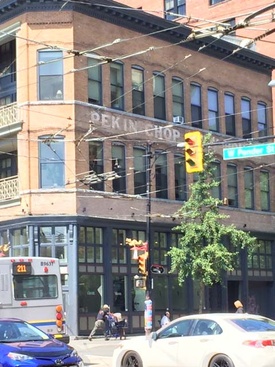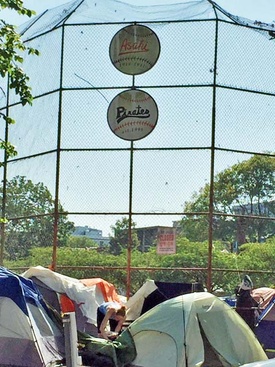For those who may not be familiar with it, can you give a summary of the events leading up to the 1907 Riot? What happened and what was the aftermath? Didn’t things get worse after that for Asians? What about the racists?
The 360 Video Walking Tour of the 1907 Anti-Asian Riots traces the history and route of the mob that attacked the Chinese Canadian and Japanese Canadian communities following the demonstration and parade organized by the Asiatic Exclusion League in Vancouver.
The 1907 Anti-Asian Riots in Vancouver is one of the most significant events in this city’s history. 360 Riot Walk leads participants into the social and political environment of the time where many communities were targeted through legislated as well as physical acts of exclusion and violence.
The soundtrack is available in four languages of the local residents of the period: English, Cantonese, Japanese, and Punjabi. The video can be experienced on location for those who have mobile devices with cellular data, or remotely on a web browser.
In the research for this project were there some surprising discoveries? During the Powell Street Festival tour, you mentioned something about black settlements in Vancouver that was new for me. Where were they?
Sure, there were lots of surprises, such as the significant proportion of Vancouver’s population that came out for the parade and demonstration for anti-Asian legislation; estimates range up to 25,000 to 30,000 (although some are much lower) when the 1907 census count for the city was 70,000; that’s over a third of the entire city!
And I knew about the Bellingham Riots, which took place three days before Vancouver’s but didn’t know that the Punjabi mill workers, after being rounded up and beaten by the white workers, were force marched to the Canadian border. They were only allowed across because they were British subjects, and many ended up in Vancouver, just in time to witness our own race riot here.
Any particular insight into the particular brand of BC racism? Was it similar to what Asians were experiencing up and down the west coast of the US?
I haven’t done a comparative historic look at how Asians were treated in BC vs Washington, Oregon and California, so I’m not really able to answer that question. But it’s clear that conditions changed from the early days of the fur trade to the times of the gold rushes, and when more settlers came to this part of the world later on, the incorporation of towns, cities, states, provinces coincided with legislation to empower certain whites (because not all Europeans were considered equal or worthy) and disempower everyone else. For instance, Oregon devised a way to discourage black American settlers by passing a “Lash Law.” There were massacres of Chinese miners up and down the coast. BC pressured Ottawa to create the Chinese Head Tax, then later, the Chinese Exclusion Act. It tried to keep South Asians out by having Ottawa pass the Continuous Journey Act. And as Japanese workers started to come to BC in larger and larger numbers, the aftermath of the 1907 Riot resulted in a “Gentleman’s Agreement” between Japan and England to drastically reduce how many were allowed into Canada.
It seems that there were few champions who stood up for those who were being targeted by the racists at the time. Were there any who dared to speak in defense of Asians?
Excellent question: I’m not sure and would like to find out more. There must have been some, but it would not have been a popular position among the whites. Much of the public outcry over the 1907 Riots was based on the lawless and destructive nature of the mob, with white community and labour leaders, journalists, and politicians arguing that the “civilized” way to keep Asians out of Canada was through legislation, not violence.
Can you imagine being an Asian in 1907? Why were we so hated?
Frankly, it’s a bit difficult imagining being anyone in a different era; I’m not sure I really understand the mixed reality digital/physical world that my students live in, with their multi-tasking social media alternative realities.
Some of the animosity towards Asians then could be attributed to the lower wages they were paid, which white labour activists and labourers used as reasons for agitation and demands for exclusion. They were the targets and became scapegoats, instead of the business elite who hired them because they wanted the cheapest labour possible to build their railroads, can the fish, dig their mines.
There was also the common mentality that Asians were incompatible with whites. Canada’s longest serving prime minister, William Lyon Mackenzie King (1874-1950), wrote in his PhD dissertation for Harvard University on “Oriental Immigration to Canada”, arguing that Canada was to be a white man’s country, so restricting immigration from Asia was, as he reasoned, natural.
But one of the realities of racism is that it’s been a normal way of being for much of human history. People are tribal. And it takes work and generosity and risk to build understanding and trust. When that happens, the reward is that the world then becomes a much bigger, better and beautiful place.
The visuals with the audio are a powerful combo. What kind of feedback have you gotten from participants on the tour?
Many have appreciated the project’s contextualization of white nationalism/supremacy that was prevalent at the time, although few use those words specifically, perhaps because it sounds extreme. Some expressed appreciation for the way archival photos of the neighbourhood have been integrated into today’s urban landscape. We also created “posters” of illustrations, documents and signs onto the exterior walls of buildings as examples of anti-Asian sentiment; for the viewer to discover as they look around the 360 environment. Another comment was how the script included diverse cultural perspectives, i.e., someone might know about Japanese Canadian history, but not necessarily what the Chinese Canadians were dealing with, or about the Bellingham Riot, etc.
Any next steps for the development of it?
Maybe, as it’s a first project for me using this technology, with a very tight budget, there are some aspects I’d like to revisit or expand upon. But that’s a question of time and money, and I have other projects that need attending to.
I’ve often wondered what happened to the properties along Powell Street after WW2? What kind of businesses took the place of the JC businesses, home, etc.? Who are the owners of those properties today?
The internment of the JCs and the appropriation of their property created a vacuum in the neighbourhood that is still very evident to this day. How the properties went from being in trust to then being sold off, with the funds used to paying for internment, is astounding. The Landscapes of Injustice project is doing some terrific research and highlighting how things played out.
Did the racist politicians think that they had gotten rid of BCs JCs forever?
Politically, immigration was a federal jurisdiction, so BC anti-Asian activists lobbied Ottawa to pass laws, which it did on various occasions. But Canada could not act independently of Britain, so Ottawa often needed to be mindful of London’s position and international relationships, especially with Japan, which in 1907 was a rising imperial military power.
In the aftermath, too, can you give us a decade by decade description of what happened to Powell Street? I saw it in the 1990s and it was pretty desperate then. Does the City of Vancouver have any vision to bring back that area?
There are historians and journalists who would do a much better job of that than I could, such as Patricia Roy. It’s a complex situation, and the homelessness, lack of affordable housing, and fentanyl issues are continuing to get worse. The Downtown Eastside crisis is at an apex, and the City of Vancouver is desperate for any ways to make things better, but the other levels of government need to help out, as they control policies, laws and funding for housing, health and what is considered to be illegal vs legal drugs.
As a Vancouverite, what are your hopes for this area of Vancouver? What might need to happen to make it so?
First of all, I hope there will be less desperation in the area, not only on the streets and Oppenheimer Park with all the homeless, but in all the homes and housing, as some are so unsafe and/or restrictive that some folks have rejected the subsidized housing they’ve been assigned. I’m curious about the calls by health advocates for “safe supply” and the legalization of all drugs and what impact that would have.
What’s happening with Chinatown is different from Nihonmachi is different from Hastings between Main and Carrall. Each has their own specific challenges. Chinatown activists have been fighting to preserve its historic Chineseness (or more specifically, Cantoneseness) against the invasion of condo towers and those who follow that lifestyle and investment opportunity, but it’s a shell of its former self when it the streets were packed with people two decades ago. The Powell Street area still has the Japanese Language School and Japanese Hall, and Powell Street Festival has a significant impact at Oppenheimer Park and the area through its progressive and admirable advocacy work, but the City has rezoned it in such a way that supports, or restricts, depending on your perspective, market-driven development.
The city as a whole, but in particular, the Downtown Eastside is at a crossroads at this time. My hope is that we can build on the histories of all those who have lived here before, so that those who live here today, and those who will be here in the future can learn about and from each other.
To learn more, check out 360 Riot Walk.
© 2019 Norm Ibuki










